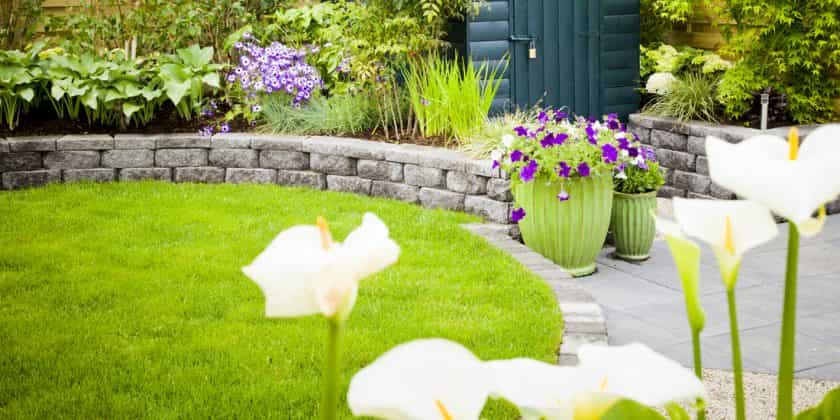Sowing Grass Seed in Summer: Can I do it?

So, you’ve been staring / glaring at your neighbours’ lush green lawn for the last few weeks and thought perhaps it’s time to sort the lawn out – once and for all, but can you still sow grass seed in summer?
Yes! It’s true that most keen gardeners will begin the process of sowing grass seed around April / May, so by the time the good weather comes around, the lawn is ready to enjoy. However, even if you’re a little bit late to the garden party, sowing grass seed in summer is still achievable, and in fact, you may see the results a lot quicker. We’ve included some extra information below about when to should use fertiliser in the summer and the best time to sow wildflower seeds.
Sowing Grass Seed in Summer
Most grass mixtures containing perennial ryegrass need around 8-10 degrees to germinate, and the UK generally begins to hit these temperatures around the end of April / beginning of May. With mixes that contain a high perennial ryegrass content – 80% and up – you could begin to see growth within ten days. Grass seed mixes that feature fescue grass seed species require slightly warmer temperatures of 15 degrees and upwards to germinate. But if temperatures drop below this slightly, it may take 3-4 weeks to see the grass start to come through. However, whether you’re going for a perennial mix, a fescue mix, or one that’s a bit of both – your seed will still germinate this summer.
Watering Grass Seed
One thing to keep in mind about sowing grass seed at this time of year is that if the weather is particularly hot or is still dried out from the previous year, it may need more watering than normal.
- We recommend watering new grass seeds once a day deeply for the first six weeks.
- At most, clay soils will need approx 12mm of water, sandy soils will need 25mm, and normal soils will benefit from somewhere in between that.
- Water your lawn again in the evening if you watered it in the morning and find the soil is dried out by the afternoon.
- You can avoid watering your grass on days when it's raining outside.
Using Fertiliser for Sowing Grass Seed in Summer
Yes, you can still use fertiliser, too – and it’s a great time to apply as lawns will need feed to keep their greenness throughout the summer if you haven’t already fed it! We have four options for summer lawn feed, and we recommend applying these two weeks before sowing grass seed. This gives the fertiliser granules time to be absorbed into the soil to benefit your grass.
QUICK RELEASE: Pre-Seed
Apply before August. Our QUICK RELEASE: Pre-Seed is a feed that is high in phosphate; this is a key ingredient to help strengthen the roots of new seedlings and improve seed-to-soil contact. Apply this fertiliser two weeks before sowing your grass seed and water in until the granules are fully dissolved.
QUICK RELEASE: Spring / Summer
Apply before August. Our QUICK RELEASE: Spring / Summer fertiliser is a booster feed that is rich in nitrogen, giving your grass an intensive green treatment. This feed lasts for six weeks, but you should avoid application during very hot periods. We recommend applying on cooler evenings or overcast days. As with all granular fertilisers, make sure to water it in until it disappears into the soil.
SLOW RELEASE: Spring / Summer
Apply our SLOW RELEASE: Spring / Summer fertiliser before August. This fertiliser is a four-month feed that slowly releases nutrients into your soil, providing a balanced feed to enhance established lawns. Again, ensure to water the granules until they have completely dissolved.
Feed, Weed and Mosskiller
Ah yes, there are some still some folk in June thinking it may be a good idea to get rid of the weeds and moss in their lawn! In our book, almost anytime (apart from winter) is a good time to free your lawn of weeds and moss. Apply this Feed, Weed and Mosskiller that conveniently does three jobs in one, and see your moss and weeds disappear, and your lawn get that feed it so desperately needs!
At this time of year, do NOT sow seed and spread fertiliser together. This is because grass grows faster in summer, and the fertiliser will damage the grass if it's not fully absorbed.
Sowing Wildflower Seed
You can indeed sow wildflower seed now, but for the best results, the ideal time to sow wildflower seed is in autumn. This does mean waiting until September, but by the time May comes around, your wildflowers will be bursting into bloom.
Benefits of Sowing Grass Seed in Summer
Sowing grass seed in summer is fine when you take the correct approach, and it’s not too late to turn that garden around! Grass seed prefers warmer temperatures, but not too hot! Delay planting grass seed until conditions return to normal if your weather forecast is showing temperatures of 20°C and above. Sowing your lawn seed in summer will provide faster germination and rapid growth when the conditions are right, and you have followed our advice on how to sow grass seed.
If you have any questions about sowing grass seed in summer or any time of the year, please get in touch, and we will happily help.